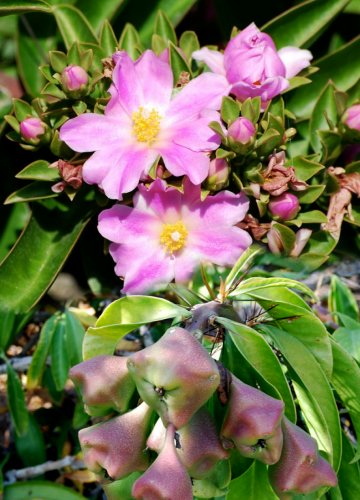
|
|
Rose Cactus (Pereskia grandifolia).
Flowers and fruits.
|
Rose Cactus - Pereskia grandifolia
Pereskia, as traditionally circumscribed, is a genus of 17 tropical species and varieties of cacti that do not look much like other types of cacti, having substantial leaves and thin stems. They originate from the region between Brazil and Mexico. Members of this genus are usually referred to as lemon vines, rose cacti or leaf cacti, though the latter also refers to the genus Epiphyllum. The genus is named after Nicolas-Claude Fabri de Peiresc, a 16th-century French botanist.
Species of Pereskia generally resemble other types of plants, such as roses. Pereskia species have large, bright green, privet-like leaves and long spiny stems. Not always succulent plants, they can be classified as shrubs, climbing plants or slightly succulent trees. However, close examination shows spines developing from areoles, and the distinctive floral cup of the cactus family. Unlike Pereskiopsis, Maihuenia, Quiabentia and Austrocylindropuntia which have persistent succulent leaves, Pereskia is the only cactus genus that has persistent non-succulent leaves. It is believed that the ancestor of all cacti resembled
Pereskia.
Pereskia grandifolia (Rose Cactus; syn. Cactus grandifolius Link, Rhodocactus grandifolius (Haw.) F.M.Knuth, Cactus rosa Vell.) is a tree native to the Northeastern Brazil restingas. This plant is often used as a medicinal plant and an ornamental plant. In addition, it has edible leaves.
Pereskia grandifolia is ever green to deciduous (depending on growing conditions) small tree or shrub, 2 to 5 m tall with a rounded crown. It is an example of a non-succulent primitive
cactus. This is an odd cactus with areoles and (surprise) with woody trunk.
Although it is a cactus by classification, it takes the form of a shrub or small tree, 2-5 metres high, with a grayish-brown trunk up to 20 cm in diameter. The areolees are rounded cushion-shaped grayish or brownish tomentum; on the twigs they are 3-7 mm diameter and up to 12 mm on the main trunk. The spines range from black to brown, the number at each areole gradually increasing with age; new twigs can have spineless areoles, while the trunk areoles may have up to 90 spines, each 2-6.5 cm long. The leaves
are thick but fleshy, vary in size from 9-23 cm long, entire, with shapes ranging from elliptic to ovate and obovate-lanceolate. Venation pinnate and prominent below.
The flowers are showy and rose-like, 3-5 cm in diameter, lasting for 2 days, sepals green, petals usually pink or purplish (but also white or tan) in short few flowered terminal panicles, centered by yellow stamens with red filaments, the stigma and style is white. Ovary bearing large leaves.
The dense inflorescence develops at the ends of stems, usually with 10-15 flowers, but sometimes with 30 or more. Flowering is during warm months and fruit is born by the flowers.
The fruit is 4-10 cm long, red, green or (usually) yellow coloured pear-shaped and more or less triangular. This fruit is a curious proliferating structure, bearing 3-4 cm long leaves, which ultimately fall away, looking more part of the stems than actual fruits. Several may seeded fruit are attached at a single peduncle. It smells good and is considered by some edible only at full ripening (otherwise it is very
astringent). The leaves are used in green salads, or can be cooked.
Leuenberger recognizes varieties grandifolia and violacea. Var. grandifolia is distinguished by having green bracts and a pink flower; it is native to eastern Brazil but widely cultivated in the tropical Americas.
Var. violacea has purplish-pink or purple bracts and flowers. It was discovered sometime before 1972, initially described as P. bahiensis, but is only distinguished from var. grandifolia by colour. It is apparently native to Espirito Santo and Minas Gerais, but planted by locals in neighbouring states.
In cultivation Pereskia grandifolia
is n Nearly indestructible. The plant requires full sun or light shade (but withstand dense shade) and well drained soils, preferably rich neutral organic soils, but may tolerate acidic ones. Drought resistant, regular water during the growing season for better growth, leaves drop during drought. Semi hardy to -3°C. Deciduous below 4°C.
It's very easy to propagate from cuttings or seeds, contrarily to most other cacti, Pereskia cuttings should be planted immediately without a dry out period. (you can also let them sit in a jar of
water).
Unusual in Collections Pereskias are really not very well-known and usually found only in botanical gardens. The real reason for their rarity has something to do with the fact they need highly a tropical climate to prosperate. Yet, they are very interesting plants.
Source:
http://en.wikipedia.org/wiki/Pereskia
http://en.wikipedia.org/wiki/Pereskia_grandifolia
http://www.cactus-art.biz/schede/PERESKIA/Pereskia_grandiflora/
Pereskia_grandiflora_violacea/Pereskia_grandiflora_violacea.htm
